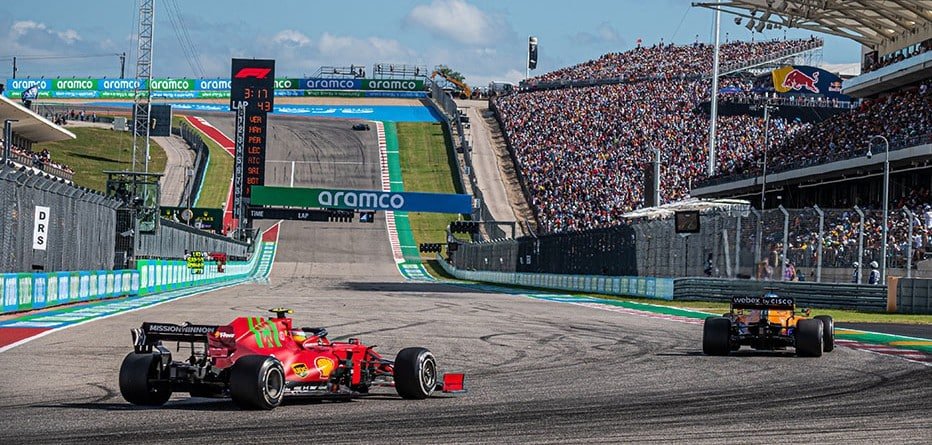Famous for its luxurious fun and glitz, Formula One, also called F1, has been notorious in single-seater motorsports. But as the conversation around climate change has intensified, Formula 1 is in the spotlight with concerns about its carbon footprint and what the sports company is doing to reduce it.
As Formula 1 goes to Las Vegas for the first time this Friday, more eyes are prying into the company’s sustainability efforts.
How Much Does F1 Contribute to Global Warming?
Given how much carbon dioxide cars emit each year, it’s not surprising that F1 has been heavily scrutinized by environmentalists.
So, how much carbon dioxide does the car racing company release to the atmosphere?
According to F1’s 2019 sustainability report, when it first announced its 2030 net zero emissions target, the company emitted 256,551 tonnes of CO2. This carbon footprint is emitted by 10 teams, 20 car units, and 23 racing events in various locations.

As seen above, the bulk of the footprint (45%) came from logistics or emissions from air, sea, and road transportation. This is the same with other popular sports where the majority of the pollution is from players and fans traveling.
Similarly, up to 85% of emissions by professional sports events come from the travel and accommodation of fans.
- RELATED: First NFL Team to Buy Carbon Credits
Another major contributor to F1’s emissions is the energy needed to power its race tracks, particularly for events at night. Add to this the emissions associated with car production and track maintenance, which have been increasing over the years.
Formula 1’s environmental impact is undeniable. As F1 race cars’ engines burn massive amounts of fossil fuels, the company is keen to lower its emissions.
To address its huge CO2 footprint, Formula 1 pledged to reach net zero emissions by 2030. The company also aims to make each race sustainable by 2025.
What is F1 Doing to Hit Its Net Zero Destination?
Same as Formula 1, the International Automobile Federation (FIA) also aims to be net zero by 2030. But compared to F1, its carbon footprint of 18,910 tonnes of CO2e in 2019, is far way lesser.
Still, motor car racing doesn’t bode well for the planet and the sport company knows this for sure. For years, F1 has been looking for ways to reduce its carbon emissions through using different means.
Ross Brawn, the company’s Managing Director of Motorsports, said that:
“As always, there is never one silver bullet to these challenges. There are a whole array of changes we have to make, from on the track to where we work.”
The company was able to reduce its footprint by 17% over the first 2 full years since 2019. Such reduction is achieved through a combination of various initiatives.
-
Use of sustainable fuels
Formula 1 has successfully introduced E10 fuel, composed of 10% ethanol, to its power units, reducing total carbon emissions. With that, the sports company intends to run its cars on 100% sustainable fuels in partnership with Saudi Arabian Aramco and other major fuel companies.
The new engine formula will be available by 2026. It’s a drop-in fuel as it is ready for use in the same formula in internal combustion engines (ICE). Formula 1 plans to partner with F2 and F3 to test the cleaner fuel.
The sustainable fuels will use a carbon capture technology or municipal wastes to further reduce CO2 emissions. These alternative fuels can offer up to 96% carbon emission reductions.
- READ MORE: Formula 1 is Going Net Zero
-
Use of renewable energy
F1 garnered the topnotch sustainability management accreditation awarded by the motorsport governing body FIA for using 100% renewable energy in its offices.
Also under this means, the company turns to solar panels for powering up some venues. Other circuits are 100% renewable powered, too.
-
Other sustainability measures
- Standardizing cars using V6 engines: The V6 engines are much smaller, designed for fuel efficiency and promoting environmentally-friendly car motor racing.
- Single-use plastics
- Incentives for fans to use greener ways to go to events
- Re-using and recycling wastes in events
- Recycling tires as fuel for cement manufacturing
The Race to Sustainability is On
Some F1 drivers are also contributing individually to the company’s sustainability and climate actions. For instance, world champ Sebastian Vettel has been opting out of air travel going to racing events. Instead, he drove to races to reduce his travel emissions.
The professional motorsport company is also supporting climate projects, including Rimba Raya Biodiversity Reserve in Indonesia and renewable energy generation projects in Zambia and India.
To meet the company’s minimum 50% emissions reduction commitment, they’re engaging with key stakeholders across the sport to materially change their operations and reduce emissions that the sport’s company has direct control.
Any remaining unavoidable emissions will be offset using credible programs that are certified by international standards, tracked on leading registries, and in line with latest best practice guidance.
Looking ahead, Formula 1 is planning to further improve logistics to the Grand Prix to cut the sport’s CO2 footprint. As the Las Vegas Grand Prix is around the corner, fans (and critics) are on the move to witness F1’s biggest best ever.
F1 Las Vegas GP ticket prices are going down significantly. Friday prices dropped by 62% (from $825 to $312) while Saturday prices decreased 34% (from $1,645 to $1,087).
The sport’s sustainability efforts are promising, but they’re just the beginning of the race. With seven more years to go until 2030, Formula 1 is racing towards its net zero goal.

